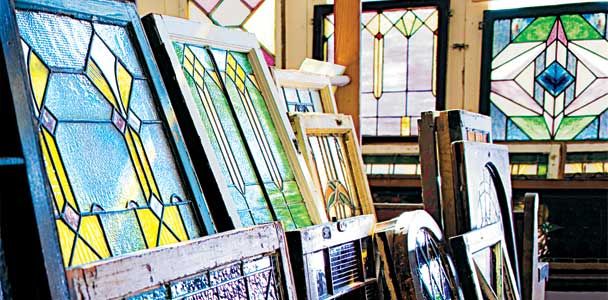Stained glass windows have adorned homes for centuries, and it’s easy to see why. These windows add a touch of elegance and artistry to residential and commercial buildings while offering privacy and natural light. From Craftsman-style homes to Victorian mansions, stained glass windows have evolved in design and application. Let’s explore the history, types, and benefits of stained glass windows in houses, as well as their maintenance needs and modern-day value.
A Brief History of Stained Glass in Residential Architecture
Stained glass windows have a rich history that dates back to ancient times, but their use in residential architecture gained popularity during the late 19th and early 20th centuries. Unlike their predecessors in religious buildings, which often depicted biblical scenes, residential stained glass focused more on decorative patterns and nature-inspired designs.
The Arts and Crafts movement of the late 1800s played a major role in popularizing stained glass in homes. This period saw a revival of handcrafted elements in architecture, with stained glass becoming a sought-after feature in Craftsman, Queen Anne, and Tudor-style houses. The colorful windows were prized for their ability to provide privacy and beautify living spaces without sacrificing natural light.
Types of Stained Glass Windows in Homes
Stained glass windows come in various styles. Let’s explore some of the most common types found in houses.
Craftsman-Style Stained Glass
Craftsman-style stained glass is characterized by simple geometric patterns and nature-inspired motifs. These windows often feature earthy colors and depictions of oak trees, acorns, or other elements from the natural world. The designs typically emphasize straight lines and angular shapes reflective of the aesthetic of Craftsman architecture.
Victorian and Queen Anne Stained Glass
Victorian and Queen Anne-style homes often showcase more ornate stained glass designs. These windows may feature intricate floral patterns, jewel-toned colors, and elaborate borders. Curved lines and asymmetrical designs are common, mirroring the decorative excesses of the Victorian era.
Art Nouveau and Art Deco Designs
Art Nouveau stained glass windows are known for their flowing, organic shapes and nature-inspired themes. These designs often incorporate stylized flowers, vines, and curved lines. In contrast, Art Deco stained glass features bold geometric patterns, sunburst motifs, and streamlined designs.
Functions and Benefits of Stained Glass Windows
One of the main functions of stained glass windows is to provide privacy without sacrificing natural light. The textured and colored glass obscures the view from the outside while still allowing sunlight to filter through, creating a warm and inviting atmosphere inside the home. This makes stained glass an excellent choice for bathrooms or street-facing windows.
Stained glass windows can also serve as focal points in a room, creating visual interest and enhancing the overall decor. The wide range of colors, patterns, and designs available allows homeowners to express their styles and complement their home’s architecture.
Popular Locations for Stained Glass in Houses
Stained glass windows can be incorporated into various areas of the home. Here are some common placements for these decorative elements:
- Bathrooms and kitchens: Stained glass windows can add a splash of color and personality to these functional spaces, turning them into more visually appealing areas of the home.
- Entryways: This application adds curb appeal and provides privacy while welcoming visitors with a colorful display.
- Skylights: These installations allow extra light to enter the room while adding a decorative touch.
- Staircases and hallways: These locations benefit from the enhanced light diffusion and add an element of surprise and charm as you move through these transitional spaces.
Maintaining and Preserving Stained Glass Windows
Cleaning stained glass requires a gentle approach to avoid damaging the glass or lead cames. Use a soft, lint-free cloth or a natural-bristle brush to remove dust and debris. A mixture of mild soap and distilled water can be used for a more thorough cleaning, followed by a rinse with clean water and drying with a soft cloth. Avoid harsh chemicals or abrasive materials that could scratch or discolor the glass.
Over time, stained glass windows may require professional repair or restoration. Common issues include cracked or broken glass, deteriorating lead cames, or sagging panels. Address these problems promptly to prevent further damage. For complex repairs or valuable antique windows, consult a professional stained glass artisan who specializes in restoration work.
The Value of Stained Glass Windows in Modern Homes
Well-maintained stained glass windows can increase a home’s value—particularly in historic properties or those with architectural significance. These unique features often appeal to buyers looking for character and craftsmanship in a home. However, the impact on property value can vary depending on the quality, condition, and style of the stained glass.
Stained glass windows can also contribute to a home’s energy efficiency by providing insulation and reducing the need for artificial lighting. Some modern stained glass installations incorporate energy-efficient materials and techniques, such as double-glazing or low-E coatings, to enhance their thermal performance while maintaining their decorative appeal.
DIY vs. Professional Installation of Stained Glass
If you’re interested in adding stained glass to your home, there are options for both DIY projects and professional installations.
Creating Your Own Stained Glass Pieces
Basic stained glass techniques can be learned through classes or online tutorials. However, note that crafting high-quality, durable stained glass windows requires skill, specialized tools, and experience.
Hiring a Stained Glass Artisan
For larger projects or more complex designs, hiring a professional stained glass artisan is often the best choice. These experts can create custom designs that perfectly complement your home’s architecture and your personal style. Professional installation also ensures that the windows are properly fitted and sealed.

